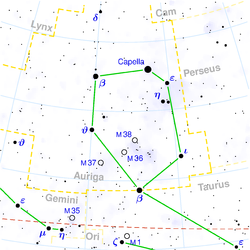
Tau Aurigae
Encyclopedia
Tau Aurigae (τ Aur, τ Aurigae) is a triple star system in the constellation
Auriga
. It is approximately 213 light-years from Earth.
The primary component, τ Aurigae A, is a yellow G-type
giant
with an apparent magnitude
of +4.51. It has two 12th magnitude companions, τ Aurigae B and C, 39.4 and 49.6 arcseconds away respectively.

Constellation
In modern astronomy, a constellation is an internationally defined area of the celestial sphere. These areas are grouped around asterisms, patterns formed by prominent stars within apparent proximity to one another on Earth's night sky....
Auriga
Auriga (constellation)
Auriga is a constellation in the northern sky. Its name is Latin for 'charioteer' and its stars form a shape that has been associated with the pointed helmet of a charioteer. It was one of the 48 constellations listed by the 2nd century astronomer Ptolemy, and remains among the 88 modern...
. It is approximately 213 light-years from Earth.
The primary component, τ Aurigae A, is a yellow G-type
Stellar classification
In astronomy, stellar classification is a classification of stars based on their spectral characteristics. The spectral class of a star is a designated class of a star describing the ionization of its chromosphere, what atomic excitations are most prominent in the light, giving an objective measure...
giant
Giant star
A giant star is a star with substantially larger radius and luminosity than a main sequence star of the same surface temperature. Typically, giant stars have radii between 10 and 100 solar radii and luminosities between 10 and 1,000 times that of the Sun. Stars still more luminous than giants are...
with an apparent magnitude
Apparent magnitude
The apparent magnitude of a celestial body is a measure of its brightness as seen by an observer on Earth, adjusted to the value it would have in the absence of the atmosphere...
of +4.51. It has two 12th magnitude companions, τ Aurigae B and C, 39.4 and 49.6 arcseconds away respectively.

Components
| NAME | Right ascension Right ascension Right ascension is the astronomical term for one of the two coordinates of a point on the celestial sphere when using the equatorial coordinate system. The other coordinate is the declination.-Explanation:... |
Declination Declination In astronomy, declination is one of the two coordinates of the equatorial coordinate system, the other being either right ascension or hour angle. Declination in astronomy is comparable to geographic latitude, but projected onto the celestial sphere. Declination is measured in degrees north and... |
Apparent magnitude Apparent magnitude The apparent magnitude of a celestial body is a measure of its brightness as seen by an observer on Earth, adjusted to the value it would have in the absence of the atmosphere... (V) |
Spectral type | Database references |
|---|---|---|---|---|---|
| ADS 4398 B (BD+39 1418B) | 05h 49m 10.0s | +39° 11' 32 | 11.6 | Simbad | |
| ADS 4398 C (BD+39 1418C) | 05h 49m 13.0s | +39° 11' 33 | 11.6 | Simbad |

